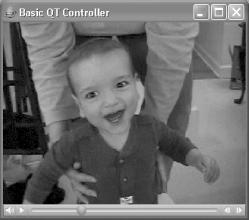Adding a Controller
This
application isn’t
particularly user-friendly yet—the user can’t
start or stop the movie, move through it, or set the volume.
Fortunately, it’s easy to use a
MovieController
to get the standard QuickTime controller
bar, an on-screen control widget that provides a play/pause button, a
volume control, and the movie position control (typically called a
“scrubber” in QuickTime parlance).
How do I do that?
Create a new class in the source file
BasicQTController.java. The main() is exactly the same as before, while the constructor adds
one new line and changes another, as seen in Example 2-2.
Example 2-2. Getting a movie component with a controller
public class BasicQTController extends Frame {
public BasicQTController (Movie m) throws QTException {
super ("Basic QT Controller");
MovieController mc = new MovieController(m);
QTComponent qc = QTFactory.makeQTComponent (mc);
Component c = qc.asComponent( );
add (c);
pack( );
}Note
Compile and run this example with ant run-ch02-basicqtcontroller.
The result, when run, looks like the application in Figure 2-3. Notice the presence of the classic QuickTime control bar at the bottom of the window.

Figure 2-3. Movie with on-screen controller
What just happened?
This time, instead of asking the QTFactory to make
a QTComponent from the Movie,
the program creates a MovieController object from
the Movie and asks the
QTFactory to make ...
Get QuickTime for Java: A Developer's Notebook now with the O’Reilly learning platform.
O’Reilly members experience books, live events, courses curated by job role, and more from O’Reilly and nearly 200 top publishers.

